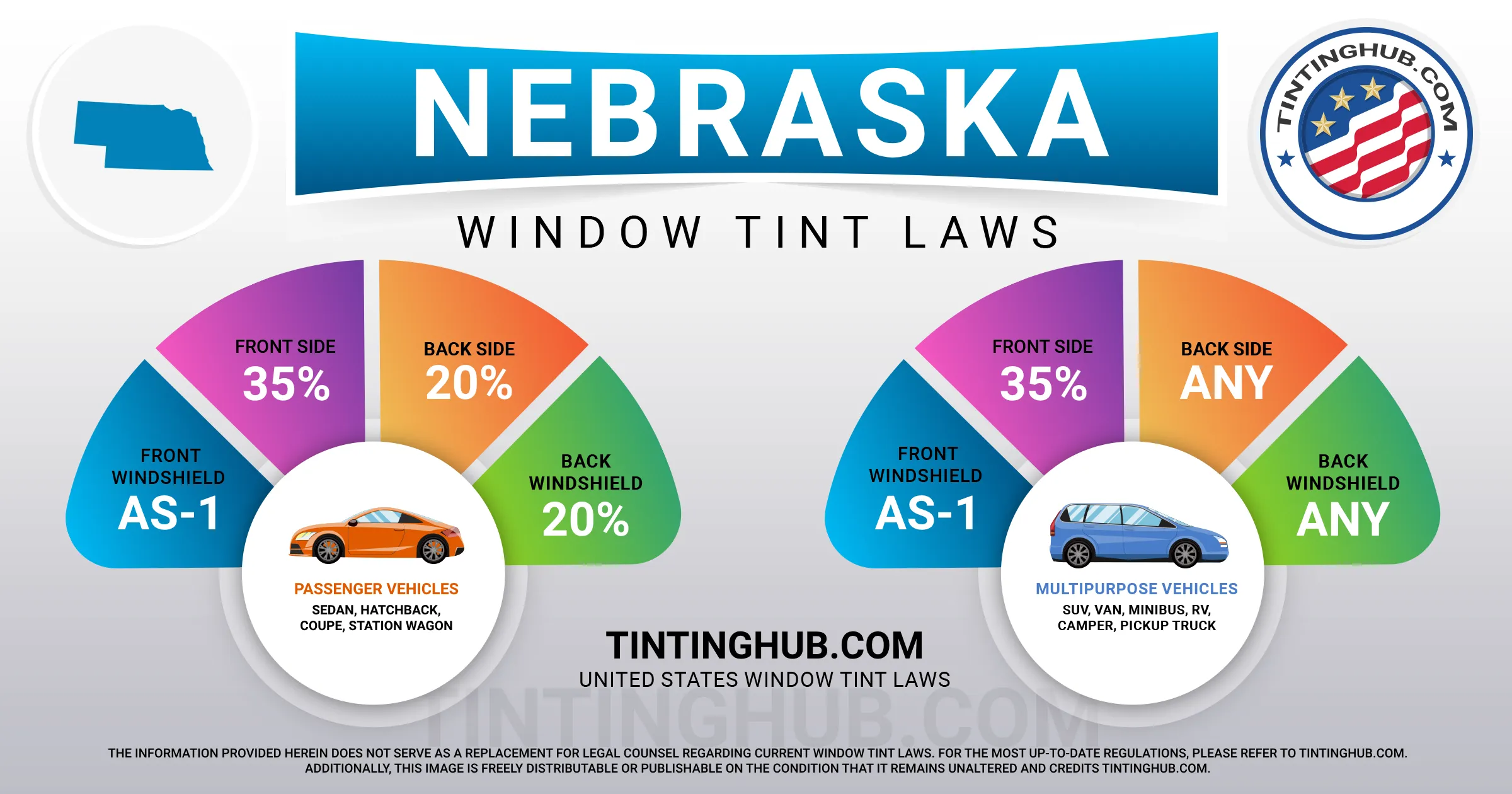Nebraska Window Tint Laws (Last Update 2024)

In the world of vehicular aesthetics, window tinting is both a stylish and practical choice. However, before you dive into the world of tinted windows in Nebraska, it’s vital to comprehend the state’s regulations to ensure you stay within the legal boundaries. Let’s explore the Nebraska Window Tint Law and its finer details.

Nebraska Window Tint Law Overview
Nebraska, like many states, has established strict guidelines for window tinting on various types of vehicles. These laws were implemented in 2006 to address issues related to safety and visibility. To help you navigate these regulations, we’ve outlined the key elements below.
Windshield Tinting
- Sedan: The windshield of a sedan is subject to specific rules. Non-reflective tint is permitted above the manufacturer’s AS-1 line. This ensures that the tinting does not impair the driver’s visibility.
Front Side Windows
- Sedan: For sedans, the front side windows must allow more than 35% of light transmission. This regulation aims to strike a balance between privacy and road safety.
Back Side and Rear Windows
- Sedan: Back side and rear windows on sedans must permit more than 20% of light transmission.
- SUV and Vans: In contrast, SUVs and vans have more flexibility. The regulations do not specify a specific VLT percentage, allowing for darker tints. However, remember that Nebraska prohibits tints that substantially impair the ability to see into the vehicle. Hence, it’s wise to exercise caution when applying darker tints.
Visible Light Transmission (VLT) in Nebraska
Understanding VLT is crucial when adhering to Nebraska’s window tint laws. VLT, or Visible Light Transmission, represents the percentage of light allowed through your car’s windows. The VLT requirements are distinct for sedans and SUVs or vans.
Tint Darkness for Sedans
- Windshield: Non-reflective tint above the manufacturer’s AS-1 line is allowed.
- Front Side Windows: These windows must permit more than 35% of light transmission.
- Back Side Windows and Rear Window: These windows must allow more than 20% of light transmission.
Tinting Darkness for SUVs and Vans
- Windshield: Similar to sedans, non-reflective tint above the manufacturer’s AS-1 line is permissible.
- Front Side Windows: These windows must also allow more than 35% of light transmission.
- Back Side Windows and Rear Window: SUVs and vans have more freedom in this regard, as they can have any level of darkness. However, the “ability to see into the motor vehicle” should not be substantially impaired.
Tint Reflection in Nebraska
Tint can serve not only to enhance the appearance of your vehicle but also to reflect incoming light, reducing glare and heat. Nebraska’s window tint law outlines specific requirements for tint reflection.
Tint Reflection for Sedans
- Front Side Windows: These windows must not be more than 35% reflective.
- Back Side Windows: Similar to front side windows, the back side windows must not exceed 35% reflectiveness.
Tint Reflection for SUVs and Vans
- Front Side Windows: Just like in sedans, the front side windows in SUVs and vans must not be more than 35% reflective.
- Back Side Windows: The regulations for back side windows in SUVs and vans mirror those for sedans, with no more than 35% reflectiveness allowed.
Additional Regulations
In addition to the fundamental rules mentioned above, Nebraska has a few more regulations and requirements related to window tinting. It’s essential to be aware of these to ensure full compliance.
Side Mirrors
Nebraska state law does not specify side mirror requirements, so vehicles may or may not have them.
Restricted Colors
Nebraska law prohibits the use of RED, AMBER, and YELLOW colors on windshields.
Certificates
Manufacturers of window tint film do not need to certify the film they sell in Nebraska.
Stickers
There are no specific stickers required to identify legal tinting in Nebraska.
Medical Exceptions
Nebraska law does not provide for medical exemptions that would allow you to use special tint for medical reasons.
Penalties
Violation of Nebraska’s window tinting laws can result in a Class V misdemeanor. It’s crucial to adhere to these regulations to avoid legal consequences.
Local Variations
Keep in mind that interpretations of Nebraska’s tinting laws may vary in different counties or places of residence. To ensure compliance, it’s advisable to double-check this information with your local DMV or law enforcement authorities.
Conclusion
Understanding Nebraska’s window tinting laws is vital when considering tinting your vehicle’s windows. By following these regulations, you can ensure your vehicle is stylish while remaining safe and compliant with the law. Our information on window tint laws in Nebraska was last updated in 2023. If you find any information that is not up to date or correct, please contact us so that we can rectify it. We are a trusted industry leader dedicated to providing accurate information on window tint laws.